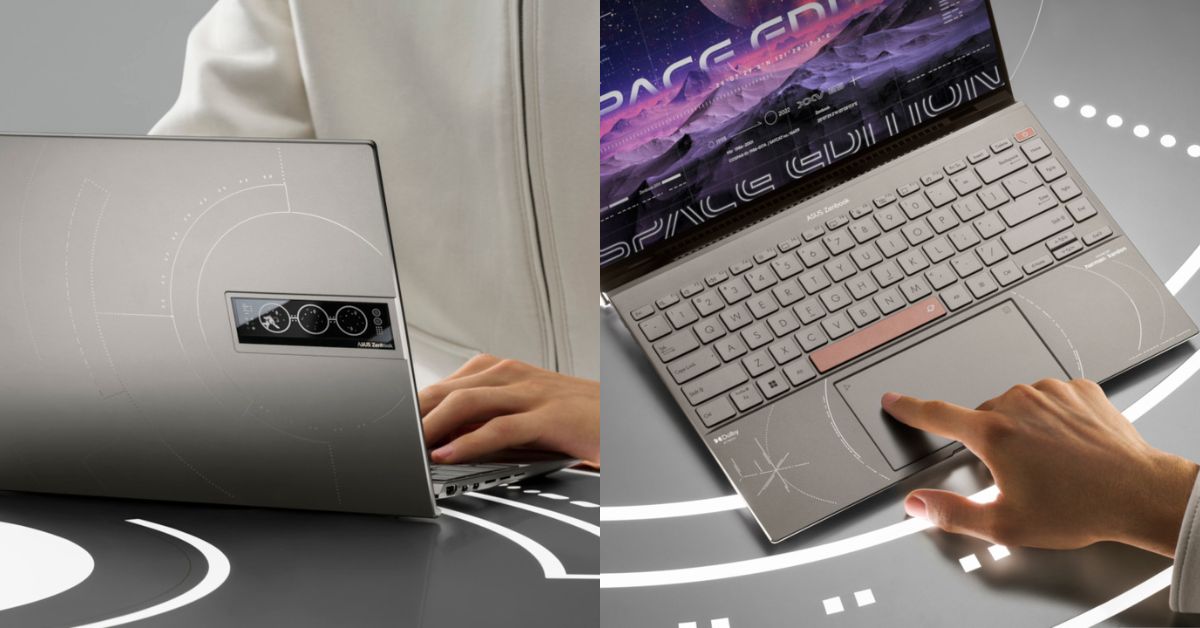[This is a sponsored article with ASUS.]
Laptops nowadays look very generic. They all sport almost the same form with a minimalistic design, 16:9 aspect ratio display, and the same 75% LED-backlit keyboard that’s nothing to write home about.
As someone who’s been in the consumer electronics industry for a number of years, I’ve noticed that ASUS is one of those brands that’s constantly challenging the norm.
They were one of the first laptop makers to release a dual-screen laptop, namely the ASUS Zenbook Pro Duo in 2019.
On top of that, they equipped their flagship gaming laptops with the AniMe Matrix, a simple display that allowed users to display custom pixel art and animations on the lids of their Zephyrus laptops.
This year, in order to commemorate the 25th anniversary of sending their first laptop into space, ASUS launched the ASUS Zenbook 14X OLED Space Edition, starting from RM5,599.
But how does it set itself apart from the rest of ASUS’ Zenbook lineup?
Premium-looking space-themed design
Similar to ASUS’ tagline, “Beyond Innovation, Inspired Creativity”, the Zenbook 14X OLED Space Edition features a unique design, with only one colour variant, the Zero-G Titanium.

If you look closely, it has a slightly copper-ish accent, and a space themed-line art.
On top of that, it’s the first to sport a ZenVision smart display, which is a small 3.5-inch monochrome display that can be seen on the laptop’s lid.

By using the software that came bundled with the laptop, you can display custom pixel art that you’ve drawn yourself.
It comes with several preset animations, a clock, and a battery indicator that lets you check the remaining battery without flipping up the lid.
In terms of ergonomics, the laptop has an ErgoLift feature, which raises the back of the laptop slightly to help improve posture and airflow.

But that’s not all, as ASUS also put some thought into the packaging.
If you split one of the containers into two separate pieces, it doubles as a laptop stand that angles the laptop by 23 degrees for improved ergonomics.
Into the specs
When it comes to the tech specs, the ASUS Zenbook 14X OLED Space Edition comes with hardware that you would typically find around this price range such as:
| Processor | – Intel® Core™ i5-12500H |
| Storage | – 16GB RAM – 512GB M.2 NVMe SSD |
| Display | – 14-inch 2.8K (2880 x 1800) 16:10 aspect ratio OLED display – HDR – 92% screen-to-body ratio – 100% DCI-P3 colour gamut – Up to 550 nits peak brightness – Pantone validated – VESA-certified Display HDR True Black 500 |
| Graphics Processor | – Intel Iris Xe Graphics |
| Connectivity | – Wi-Fi 6E – Bluetooth 5.2 |
| I/O | – 1x USB 3.2 Gen 2 Type-A – 2x Thunderbolt 4 – 1x HDMI 2.0b – 1x 3.5mm Combo Audio Jack – Micro SD card reader |
| Weight | – 1.4kg |
| Dimensions | – 311.2 x 221.1 x 159mm |
| Features | – US Space Systems Command Standard (SMC-S-016A) – ZenVision Smart Display – ASUS ErgoSense keyboard – Harmon Kardon-tuned speakers – Electric webcam shield – Fingerprint sensor – ASUS NumberPad 2.0 |
There’s a slightly more expensive variant at RM6,499 that comes with largely the same components as the RM5,599 variant, though it has a faster Intel Core i7-12700H processor, and a larger 1TB M.2 NVMe SSD too.
While the laptop itself doesn’t come with a dedicated RJ45 ethernet port built-in, there is a USB-A to RJ45 gigabit ethernet adapter out of the box.

Other than the tech specs, the laptop has a few interesting features worth mentioning too.
These include the Electric Webcam Shield, which has a dedicated button that blocks the camera vision in order to protect your privacy. Meaning, no more applying stickers or tape onto your laptop’s webcam.
The speakers are also tuned by Harmon Kardon to deliver loud, crisp-sounding audio.
They’re compatible with Windows Hello for quick and secure sign-in with the fingerprint sensor-integrated power button.
If you’re the kind of person that utilises the numpad often, you might prefer getting a laptop that has a dedicated numpad.

At first glance, the laptop does not seem to feature a numpad. But if you tap on the small numpad icon on the top right of the touchpad, it activates the ASUS NumberPad 2.0, which is basically a digital numpad on the touchpad.
This eliminates the need to add a tactile numpad into what might already be a cramped keyboard.
On top of everything mentioned, the laptop is compatible with USB-C charging, which means it can be charged using any power bank that supports USB Power Delivery (USB-PD).
Having said all that, this laptop would be suited for:
1. Business professionals & students
For example, it has the ASUS NumberPad 2.0 that could be used for data entry, cutting down the need to carry around an external numpad.
As someone who uses a 16:10 monitor at home, I can vouch that the taller aspect ratio certainly helps with reading long digital documents like contracts and reports too.
If you’re travelling often, the laptop’s power brick is not too heavy, and it can be easily charged via a power bank that supports USB-PD.
2. Content creators
Seeing as how the OLED display covers 100% DCI-P3 colour gamut, is Pantone validated, and True Black 500 VESA certified, it is also suitable for content creators in today’s digital landscape.
Since a lot of digital content these days is mostly shown in a tall 9:16 format, the taller aspect ratio of the laptop’s display gives users a better look at the content they are producing during the editing phase.
It’s also TÜV-certified for low blue-light emissions, making it easier on the eyes, especially when staring at the screen for long periods of time.
While working outdoors, the last thing any content creator would want to face is not being able to see their screen properly against the bright, direct sunlight.
Since the laptop is capable of achieving up to 550 nits peak brightness, coupled with the fact that the laptop uses an OLED panel, content creators shouldn’t face this issue.
3. Space enthusiasts
The ASUS Zenbook 14X Space Edition doesn’t just look the part, because it’s also US Space Systems Command Standard (SMC-S-016A) compliant.
This means that the laptop can withstand extreme vibrations from 20Hz to 2,000Hz, and it can operate in a wide range of temperatures from -24°C to 61°C.
ASUS laptops are also tested rigorously to ensure that they remain functional even under the most extreme circumstances.
Though it’s unlikely that many of us would ever be able to push our ASUS laptops to the limit, there have been a few fun use cases in the past, such as the very occasion the ASUS Zenbook 14X Space Edition commemorates.

It was 1997 when ASUS first sent its laptops to the MIR Space Station for a 600-day mission, and cosmonaut Sergei Avdeev commented, “We turned the notebooks on in the morning and left them on all day without a problem.”
On another occasion, the ASUS U5 notebook was also one of the first laptops to be brought up to the peak of Mount Everest.
4. Early adopters
If you enjoy being an early adopter of new tech, then this laptop coupled with its unique design might tickle your fancy.
-//-
The ASUS Zenbook 14X is a laptop worth considering if you’re a tech nerd (like myself) who likes the idea of space, or something unique.
The laptop can be purchased from any authorised ASUS stores nationwide. It’s also available for purchase on ASUS’ official website.

- Find out more about ASUS here.
- Find out more about the ASUS Zenbook 14X Space Edition here.
- Find out more about ASUS Notebooks and their history here.
Featured Image Credit: ASUS










